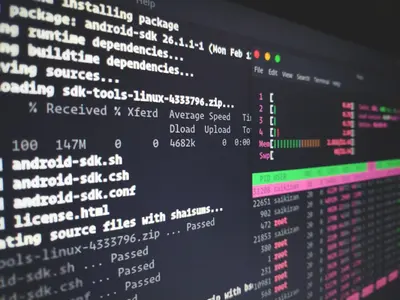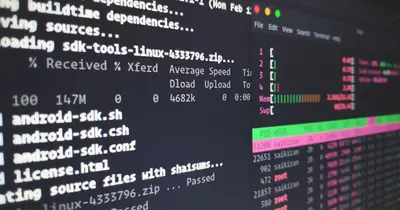⚙️ AlmaLinux Service Management: Complete systemctl Guide
Welcome to the powerful world of service management on AlmaLinux! 🎉 Think of services as the helpful workers in your Linux system - they run quietly in the background, handling everything from web servers to databases to security tools. Whether you’re managing a web server, database, or any other service, mastering systemctl is like having a remote control for your entire system! 🎮
Service management might seem technical, but it’s actually quite intuitive and incredibly powerful! 💪 From starting and stopping services to creating custom automation, we’ll learn everything step by step. Get ready to become a service management expert and make your AlmaLinux system work exactly how you want it to! ✨
🤔 Why is Service Management Important?
Service management is the heart of system administration! Here’s why you should master it:
- ⚡ System Control: Start, stop, and restart services when needed
- 🔄 Automation: Automatically start services at boot time
- 📊 Monitoring: Check service status and health continuously
- 🛡️ Reliability: Ensure critical services are always running
- 🔧 Troubleshooting: Diagnose and fix service-related problems
- 📈 Performance: Optimize service configurations for better performance
- 🎯 Resource Management: Control which services use system resources
- 🚀 Scalability: Manage services efficiently as your system grows
🎯 What You Need
Before we start managing services, make sure you have:
✅ AlmaLinux 8 or 9 installed and running ✅ Root or sudo access to manage system services ✅ Basic terminal knowledge (cd, ls, cat commands) ✅ Understanding of processes (what services are) ✅ Text editor familiarity (nano, vim, or gedit) ✅ Some services installed (most systems have several by default) ✅ Curiosity about how your system works behind the scenes!
📝 Understanding systemd and Services
Let’s start by understanding how AlmaLinux manages services! 🎓
What is systemd?
# Check systemd version
systemctl --version
# Output: Shows systemd version and supported features
# View systemd status
systemctl status
# Output: Shows overall system status and active services
# Check if systemd is the init system
ls -l /sbin/init
# Output: Should link to systemd
# View systemd configuration directory
ls /etc/systemd/system/
# Output: Shows custom service configurationsUnderstanding Service Types
# List all available services
systemctl list-unit-files --type=service | head -20
# Output: Shows services and their enable/disable status
# List all loaded services
systemctl list-units --type=service | head -10
# Output: Shows currently loaded services and their status
# List only active services
systemctl list-units --type=service --state=active
# Output: Shows only running services
# List failed services
systemctl list-units --type=service --state=failed
# Output: Shows services that failed to start🔧 Basic Service Operations
Starting and Stopping Services
# Check service status
systemctl status httpd
# Output: Shows detailed status of Apache web server
# Start a service
sudo systemctl start httpd
# Output: No output if successful
# Stop a service
sudo systemctl stop httpd
# Output: No output if successful
# Restart a service (stop then start)
sudo systemctl restart httpd
# Output: No output if successful
# Reload service configuration without stopping
sudo systemctl reload httpd
# Output: Reloads config without interrupting connections
# Check if service is active
systemctl is-active httpd
# Output: active, inactive, or failedEnabling and Disabling Services
# Enable service to start at boot
sudo systemctl enable httpd
# Output: Creates symlinks for automatic startup
# Disable service from starting at boot
sudo systemctl disable httpd
# Output: Removes symlinks, service won't auto-start
# Check if service is enabled
systemctl is-enabled httpd
# Output: enabled, disabled, or static
# Enable and start service in one command
sudo systemctl enable --now httpd
# Output: Enables and immediately starts the service
# Disable and stop service in one command
sudo systemctl disable --now httpd
# Output: Disables and immediately stops the service🌟 Advanced Service Management
Service Dependencies and Targets
# View service dependencies
systemctl list-dependencies httpd
# Output: Shows what services httpd depends on
# View what depends on a service
systemctl list-dependencies httpd --reverse
# Output: Shows what services depend on httpd
# View all system targets (runlevels)
systemctl list-units --type=target
# Output: Shows different system states
# Check current target
systemctl get-default
# Output: Shows default target (usually multi-user.target or graphical.target)
# Change default target
sudo systemctl set-default multi-user.target
# Output: Sets system to boot to command line by defaultService Logs and Troubleshooting
# View service logs
journalctl -u httpd
# Output: Shows logs for httpd service
# View recent service logs
journalctl -u httpd -n 20
# Output: Shows last 20 log entries
# Follow service logs in real-time
journalctl -u httpd -f
# Output: Shows new log entries as they appear
# View logs for specific time period
journalctl -u httpd --since "2025-09-17 10:00" --until "2025-09-17 11:00"
# Output: Shows logs for specific time range
# View logs with specific priority
journalctl -u httpd -p err
# Output: Shows only error-level messages✅ Creating Custom Services
Writing a Simple Service
# Create a simple script to run as a service
sudo nano /usr/local/bin/my-service.sh
# Add this content:
#!/bin/bash
while true; do
echo "My service is running at $(date)" >> /var/log/my-service.log
sleep 60
done
# Make script executable
sudo chmod +x /usr/local/bin/my-service.sh
# Create service file
sudo nano /etc/systemd/system/my-service.service
# Add this content:
[Unit]
Description=My Custom Service
After=network.target
[Service]
Type=simple
User=nobody
ExecStart=/usr/local/bin/my-service.sh
Restart=always
RestartSec=5
[Install]
WantedBy=multi-user.targetManaging Custom Services
# Reload systemd to recognize new service
sudo systemctl daemon-reload
# Output: No output if successful
# Start the custom service
sudo systemctl start my-service
# Output: No output if successful
# Check custom service status
systemctl status my-service
# Output: Shows status of your custom service
# Enable custom service
sudo systemctl enable my-service
# Output: Service will start automatically at boot
# View custom service logs
journalctl -u my-service -f
# Output: Shows real-time logs from your service🔧 Service Configuration and Tuning
Modifying Service Settings
# View service configuration
systemctl cat httpd
# Output: Shows the service unit file content
# Create service override directory
sudo systemctl edit httpd
# Output: Opens editor for service overrides
# Example override content:
[Service]
# Increase restart delay
RestartSec=10s
# Set custom environment variable
Environment=CUSTOM_VAR=value
# View service with overrides
systemctl cat httpd
# Output: Shows original and override configurations
# Remove service overrides
sudo systemctl revert httpd
# Output: Removes all overrides for the serviceResource Control
# Create resource-limited service
sudo nano /etc/systemd/system/limited-service.service
# Add this content:
[Unit]
Description=Resource Limited Service
After=network.target
[Service]
Type=simple
ExecStart=/usr/local/bin/my-script.sh
# Limit memory usage to 100MB
MemoryLimit=100M
# Limit CPU usage to 50%
CPUQuota=50%
# Set nice priority
Nice=10
[Install]
WantedBy=multi-user.target
# Reload and start the service
sudo systemctl daemon-reload
sudo systemctl start limited-service
# Check resource usage
systemctl status limited-service
# Output: Shows resource usage and limits🎮 Quick Examples
Example 1: Web Server Management
# Install Apache web server
sudo dnf install httpd -y
# Output: Installs Apache HTTP server
# Configure Apache to start automatically
sudo systemctl enable httpd
# Output: Enables Apache to start at boot
# Start Apache web server
sudo systemctl start httpd
# Output: Starts the web server
# Check Apache status
systemctl status httpd
# Output: Shows Apache is active and running
# Test web server
curl -I localhost
# Output: Shows HTTP response headers
# Configure firewall for web server
sudo firewall-cmd --permanent --add-service=http
sudo firewall-cmd --permanent --add-service=https
sudo firewall-cmd --reload
# Output: Opens firewall ports for web traffic
# Monitor Apache logs
sudo journalctl -u httpd -f
# Output: Shows real-time Apache logs
# Gracefully reload Apache configuration
sudo systemctl reload httpd
# Output: Reloads config without dropping connectionsExample 2: Database Service Setup
# Install MariaDB database server
sudo dnf install mariadb-server -y
# Output: Installs MariaDB database
# Start MariaDB service
sudo systemctl start mariadb
# Output: Starts database server
# Enable MariaDB to start at boot
sudo systemctl enable mariadb
# Output: Enables automatic startup
# Check MariaDB status
systemctl status mariadb
# Output: Shows database server status
# Secure MariaDB installation
sudo mysql_secure_installation
# Output: Interactive security setup
# Create database monitoring script
sudo nano /usr/local/bin/db-monitor.sh
# Add this content:
#!/bin/bash
LOG_FILE="/var/log/db-monitor.log"
if systemctl is-active mariadb >/dev/null 2>&1; then
echo "$(date): MariaDB is running" >> "$LOG_FILE"
else
echo "$(date): MariaDB is DOWN - attempting restart" >> "$LOG_FILE"
systemctl restart mariadb
fi
# Make monitoring script executable
sudo chmod +x /usr/local/bin/db-monitor.sh
# Add to crontab for regular monitoring
echo "*/5 * * * * /usr/local/bin/db-monitor.sh" | sudo crontab -
# Output: Monitors database every 5 minutesExample 3: Custom Application Service
# Create a Node.js application service
sudo mkdir -p /opt/myapp
sudo nano /opt/myapp/app.js
# Add this content:
const http = require('http');
const server = http.createServer((req, res) => {
res.writeHead(200, {'Content-Type': 'text/plain'});
res.end('Hello from My App!\n');
});
server.listen(3000, () => {
console.log('Server running on port 3000');
});
# Create dedicated user for the application
sudo useradd -r -s /bin/false -d /opt/myapp myapp
sudo chown -R myapp:myapp /opt/myapp
# Create systemd service file
sudo nano /etc/systemd/system/myapp.service
# Add this content:
[Unit]
Description=My Node.js Application
After=network.target
[Service]
Type=simple
User=myapp
WorkingDirectory=/opt/myapp
ExecStart=/usr/bin/node app.js
Restart=always
RestartSec=5
Environment=NODE_ENV=production
StandardOutput=journal
StandardError=journal
[Install]
WantedBy=multi-user.target
# Install Node.js if not already installed
sudo dnf install nodejs npm -y
# Enable and start the service
sudo systemctl daemon-reload
sudo systemctl enable myapp
sudo systemctl start myapp
# Check application status
systemctl status myapp
# Output: Shows custom application status
# Test the application
curl http://localhost:3000
# Output: Hello from My App!
# Monitor application logs
journalctl -u myapp -f
# Output: Shows real-time application logs🚨 Fix Common Problems
Problem 1: Service Fails to Start
Symptoms: Service won’t start or immediately stops
Solution:
# Check detailed service status
systemctl status service-name
# Output: Shows error messages and exit codes
# View service logs for errors
journalctl -u service-name -n 50
# Output: Shows recent log entries with error details
# Check service configuration
systemctl cat service-name
# Output: Shows service unit file content
# Validate systemd configuration
sudo systemd-analyze verify /etc/systemd/system/service-name.service
# Output: Shows configuration errors if any
# Test service command manually
sudo -u service-user /path/to/service/command
# Output: Tests if the actual command works
# Fix common issues:
# 1. Check file permissions
ls -l /path/to/service/executable
# 2. Verify user exists
getent passwd service-user
# 3. Check file paths are correct
# 4. Reload systemd after changes
sudo systemctl daemon-reloadProblem 2: Service Keeps Restarting
Symptoms: Service constantly restarts or shows restart loops
Solution:
# Check restart history
journalctl -u service-name | grep -i restart
# Output: Shows restart patterns and timing
# Check service exit codes
journalctl -u service-name -o json | grep EXIT_CODE
# Output: Shows why service is exiting
# Temporarily disable restart to debug
sudo systemctl edit service-name
# Add this override:
[Service]
Restart=no
# Reload and test
sudo systemctl daemon-reload
sudo systemctl restart service-name
# Check what's causing the exit
journalctl -u service-name -f
# Output: Monitor logs to see exit reason
# Common fixes:
# 1. Increase RestartSec value
# 2. Fix application configuration
# 3. Check resource limits
# 4. Verify dependencies are metProblem 3: Service Not Starting at Boot
Symptoms: Service works manually but doesn’t start automatically
Solution:
# Check if service is enabled
systemctl is-enabled service-name
# Output: Should show "enabled"
# Enable service if not enabled
sudo systemctl enable service-name
# Output: Creates necessary symlinks
# Check service dependencies
systemctl list-dependencies service-name
# Output: Shows what service depends on
# Check target dependencies
systemctl list-dependencies multi-user.target | grep service-name
# Output: Verifies service is in correct target
# Check for dependency conflicts
journalctl -b | grep service-name
# Output: Shows boot-time messages for service
# Verify target configuration in service file
systemctl cat service-name | grep WantedBy
# Output: Should show appropriate target
# Test boot process
sudo systemctl isolate rescue.target
sudo systemctl isolate multi-user.target
# Output: Tests target switching📋 Simple Commands Summary
| Command | Purpose | Example |
|---|---|---|
systemctl start | Start service | systemctl start httpd |
systemctl stop | Stop service | systemctl stop httpd |
systemctl restart | Restart service | systemctl restart httpd |
systemctl status | Check status | systemctl status httpd |
systemctl enable | Enable at boot | systemctl enable httpd |
systemctl disable | Disable at boot | systemctl disable httpd |
journalctl -u | View logs | journalctl -u httpd |
systemctl daemon-reload | Reload configs | systemctl daemon-reload |
💡 Tips for Success
Here are proven strategies to master service management! 🌟
Best Practices
- 📊 Monitor Regularly: Check service status and logs frequently
- 🔄 Plan Restarts: Schedule service restarts during maintenance windows
- 📝 Document Services: Keep records of custom services and configurations
- 🛡️ Security First: Run services with minimal required permissions
- ⚡ Resource Awareness: Monitor CPU and memory usage of services
- 🔍 Log Management: Configure appropriate logging levels and rotation
- 🎯 Dependency Planning: Understand service dependencies before changes
- 🧪 Test Changes: Test service modifications in non-production environments
Optimization Tips
- Use service templates for similar services to reduce duplication 📋
- Implement health checks for critical services 🏥
- Configure proper resource limits to prevent resource exhaustion 📊
- Use socket activation for services that don’t need to run constantly ⚡
- Set up service monitoring and alerting for production systems 🚨
- Use service drop-in files for configuration management 🔧
- Implement graceful shutdown procedures for data services 💾
- Regular backup of service configurations and data 🛡️
🏆 What You Learned
Congratulations! You’ve mastered service management on AlmaLinux! 🎉 Here’s what you can now do:
✅ Control Services: Start, stop, restart, and reload services effectively ✅ Manage Boot Behavior: Enable and disable services for automatic startup ✅ Monitor Service Health: Check status, logs, and troubleshoot issues ✅ Create Custom Services: Write and deploy your own systemd services ✅ Configure Advanced Features: Set resource limits and dependencies ✅ Troubleshoot Problems: Diagnose and fix common service issues ✅ Optimize Performance: Tune services for better performance and reliability ✅ Implement Best Practices: Follow security and operational guidelines
🎯 Why This Matters
Service management is the backbone of system administration! 🚀 With these skills, you can:
- Ensure Uptime: Keep critical services running reliably 24/7 ⏰
- Scale Operations: Manage complex multi-service environments 📈
- Automate Systems: Create self-healing and self-managing systems 🤖
- Optimize Performance: Fine-tune services for maximum efficiency ⚡
- Enhance Security: Run services with proper isolation and permissions 🛡️
- Simplify Maintenance: Streamline service updates and configurations 🔧
Service management transforms you from someone who manually starts programs into a system orchestrator who designs reliable, scalable infrastructures! Whether you’re running a simple web server or a complex microservices architecture, these skills are essential. Remember, great systems don’t just happen - they’re carefully designed and managed! ⭐
Excellent work on mastering AlmaLinux service management! You now have the power to create robust, automated systems that work reliably around the clock! 🙌




